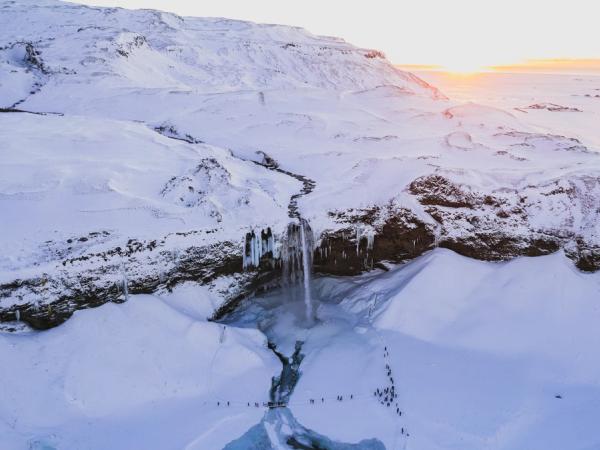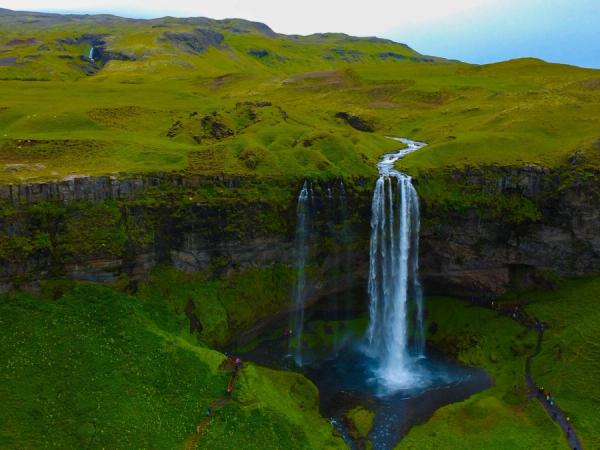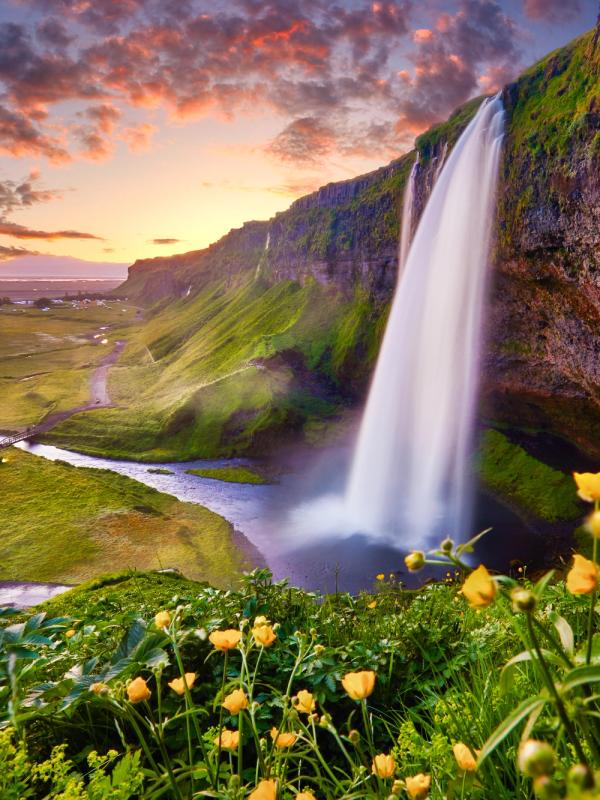
Seljalandsfoss: Complete Visitor’s Guide
There’s a theatrical quality to Seljalandsfoss that sets it apart – even in a country overflowing with dramatic waterfalls. Cascading over an ancient sea cliff and framed by mossy green walls, this 60-meter-high ribbon of water crashes into the pool below, draining away across the flat south coast towards the ocean. But what makes it truly special is the path that loops behind the falls – one of the few in Iceland where you can step inside the roar. Mist drifts across the trail like breath, and for a moment, the world becomes water, light, and sound.
Easily accessed from the Ring Road and surrounded by smaller, lesser-known falls, Seljalandsfoss offers a full sensory encounter with Iceland’s raw, glacial beauty. Here’s everything you need to know about visiting this waterfall.
Key Takeaways
- Seljalandsfoss drops 60 meters from a cliff that used to mark Iceland’s ancient coastline
- You can walk behind the waterfall – one of the few in Iceland where that’s possible
- It’s located just off the Ring Road, around 120 km from Reykjavík
- Facing to the west, it’s a popular spot to watch the sunset
- Parking now costs 900 ISK (around $7 USD)
- Nearby Gljúfrabúi waterfall hidden within the cliffs is easily accessed from Seljalandsfoss
- Best visited in summer when the path behind is snow-free, but still stunning year-round
- You will get wet walking behind it – dress accordingly
What is Seljalandsfoss?
Seljalandsfoss is a 60-meter (197-foot) tall waterfall fed by the Seljalandsá River, which flows down from the Eyjafjallajökull glacier above. The waterfall plunges off a cliff that once marked the coastline of Iceland, leaving a wide, open cavern behind the cascade – a rare feature in Iceland that lets you circle it completely.
While many Icelandic waterfalls are admired from a distance, Seljalandsfoss is one of several where you can step up right to the base of the waterfall. It’s been a beloved stop on the ring road for centuries, and with good reason. It’s the first waterfall that you’ll see as you approach Iceland’s popular South Coast, and one of the country’s most striking and memorable.
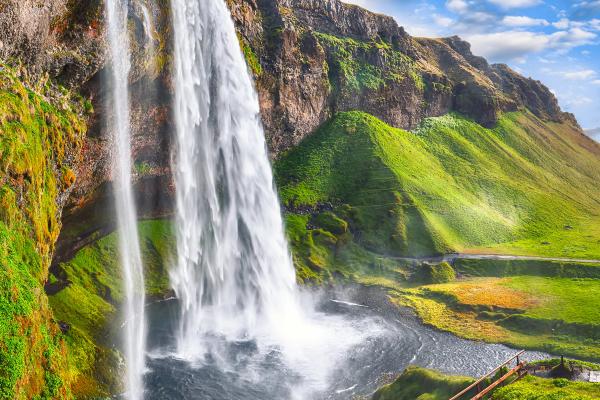
Formation & Interesting Facts
Seljalandsfoss exists thanks to thousands of years of glacial meltwater carving its way through volcanic rock. It also sits on what used to be Iceland’s coastline; as the glaciers retreated, there was significant uplift in the land, creating the lowlands along the south coast that make up the region today.
Beyond the basics, here are a few fast facts that make Seljalandsfoss stand out:
- Its water comes from Eyjafjallajökull – the infamous volcano-glacier combo that erupted in 2010
- The path behind the falls was made naturally by erosion but later reinforced for safety
- At night, it’s beautifully lit with warm spotlights so visitors can visit after sunset
- Scenes from Justin Bieber’s “I’ll Show You” music video were filmed here
- Just a short walk north is Gljúfrabúi, a partially hidden waterfall inside a mossy gorge
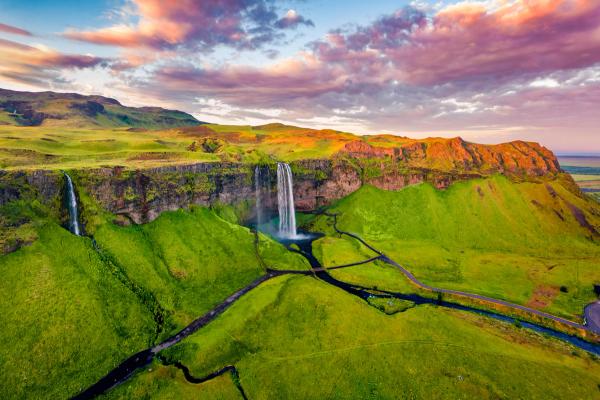
Why is it Worth Visiting?
For many, Seljalandsfoss marks the first big sight outside the Golden Circle, and officially lets you know you’ve arrived on the South Coast. The fact that you can get up so close and personal with this waterfall is also impressive; it might not be as big as Gullfoss, but there’s a surprising amount of power to witness here as the water crashes off the cliff into the river below. Plus, there’s something surreal about watching the world from behind a roaring curtain of water.
It’s also incredibly accessible. Just 2 minutes from the parking lot, it makes for a quick stop for many travelers driving along the ring road, but it’s one you won’t forget. And because it's so close to Reykjavík, it’s perfect for day trips, best combined with the other highlights along Iceland’s South Coast. If you’re road-tripping Iceland in a campervan, this is one of those easy, unforgettable stops that doesn’t take much effort to reach but makes a big impression.
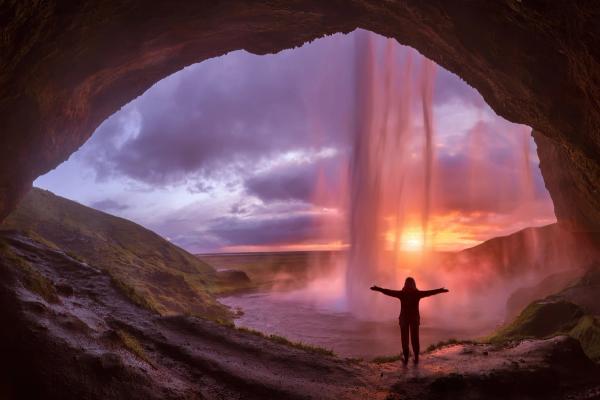
Location, How to Get There & Parking
You'll find Seljalandsfoss in South Iceland, about 120 kilometers from Reykjavík, just off Route 1 (Ring Road). It’s located between the towns of Hella and Skógar, making it a popular first stop on most South Coast itineraries. It’s at the edge of the Highland shelf, with the glacier Eyjafjallajökull above.
By Car
The easiest way to reach Seljalandsfoss is by renting a campervan (or car), giving you the flexibility to explore at your own pace. The drive from Reykjavík takes around 1 hour and 45 minutes. Most people stop here on their way to Skógafoss, Reynisfjara Black Sand Beach, Vík, or further along the Ring Road.
- Follow Route 1 (Ring Road) east from Reykjavík
- Drive past Selfoss and Hella
- Around 25 minutes past Hella, you should be able to see the waterfall from the road. Look for the signs marking the turnoff to Road 249
- Turn left and follow signs to Seljalandsfoss – you’ll see it before you arrive
Getting There by Bus
Public transport in Iceland’s countryside is limited – as of 2025, there is no public bus that stops at Seljalandsfoss.
Parking
- As of 2025, 1000 ISK (about $7 USD) per vehicle
- Pay at the kiosk or scan the QR code on posted signs
- The fee covers Seljalandsfoss and nearby Gljúfrabúi
- Overnight parking isn’t allowed
- Toilets are available, and a food truck often parks nearby in summer
Best Time to Visit
Seljalandsfoss is worth seeing year-round, but when you go it will shape your experience at the waterfall, with each season bringing something different to the table. Here’s what to expect throughout the year.
Summer (June–August)
Summer is the best time to explore the waterfall from every angle, but unless you’re there early or late, you’ll have to battle the largest crowds:
- The path behind the falls is fully accessible and safest in summer
- Long daylight hours (nearly 24 hours in June) let you visit late in the evening without crowds
- Wildflowers and vibrant green grass surround the cliffs
- Temperatures are mild, usually 10–15°C (50–59°F)
- Great for photography and short hikes nearby
Expect most visitors between 10 AM and 4 PM, especially when tour buses arrive.
Fall (September–October)
Fall offers a quieter, moodier version of Seljalandsfoss, with fewer people but a greater chance of rain:
- The landscape shifts to golden tones, perfect for photos
- Fewer people than in summer, especially in the mornings
- Waterfall flow remains strong
- Still enough daylight for exploring comfortably
- Clear nights can offer a first glimpse of the Northern Lights
Winter (November–March)
Winter transforms Seljalandsfoss into an icy spectacle, but you’ll need to take greater care on the trails:
- The waterfall keeps flowing even in freezing temps
- Ice formations build up around the cliff and rocks
- The path behind the waterfall is most often closed due to ice
- Very few tourists visit during this time
- Short daylight hours (4–6 hours in December) require careful planning to see it in natural daylight
- Ice spikes or crampons are recommended if you're walking near the spray zone
Spring (April–May)
Spring brings new life to the south coast, and is a great time to visit:
- Snowmelt boosts the waterfall’s volume
- Fresh greenery begins to return to the area
- Fewer crowds and lower prices for accommodations
- Access behind the waterfall usually reopens by mid to late spring
- Weather can be unpredictable – pack layers and waterproof gear
Best Time of Day
For the best light, fewest people, and most atmosphere, timing matters:
- Early morning (before 9 AM) or evening (after 6 PM) offers the most peaceful experience. Exact timings shift with the seasons, as daylight hours grow longer in summer and shorter through fall and winter.
- Summer evenings bring a unique vibe, with the long daylight hours offering travelers beautiful golden hours and extended dusk conditions.
What to Wear
Iceland’s weather can shift in minutes, and Seljalandsfoss creates its own little weather system with all that spray – especially if you’re walking behind the waterfall. Even standing nearby can leave you drenched. Be prepared with the right gear.
The Essentials
- Waterproof jacket and pants: If you don’t want to get soaking wet, wearing your waterproof gear at this waterfall is a good idea. The mist wraps all the way around the path behind the falls, and you’ll get wet if you’re heading there. If not, no worries.
- Sturdy, non-slip shoes: Again, the trail behind the waterfall can be muddy and slick with water. Hiking boots with good grip are your best bet.
- Warm, moisture-wicking base layers: Even in summer, Iceland can be chilly. Base layers help regulate your temperature under waterproofs.
- Quick-dry clothes: Avoid cotton. If you get wet, it’ll stay wet and make you cold. Opt for synthetic or merino wool fabrics.

Extras by Season
- Summer: Sunglasses, a sun hat, and lighter layers that you can remove as the day warms up.
- Winter: Thermal base layers, a warm hat, waterproof gloves, a scarf, and ice spikes or crampons if you’re walking in icy conditions.
For Photographers
- Bring a microfiber cloth to wipe your lens – the spray is constant, and you don’t want your photos to come out with droplets of water on them
- Use a rain cover or plastic bag for your camera if you’re getting up real close
- A UV filter can help protect your lens from water damage
- A polarizing filter brings out rainbow colors and cuts glare on sunny days
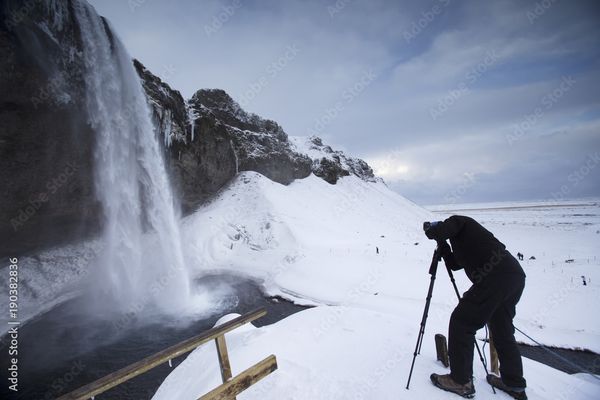
Things to Do There
There's more to do at Seljalandsfoss than just admiring the water cascading from a distance.
Walk Behind the Waterfall
The star attraction. Follow the path that loops behind Seljalandsfoss to stand inside the cascade. You'll hear it roar around you, feel the cool air shift, and watch the world through a veil of falling water. Bonus points if you’re here at sunset – watching the sun dip below the distant horizon makes for a spectacular backdrop when looking out from behind the waterfall.
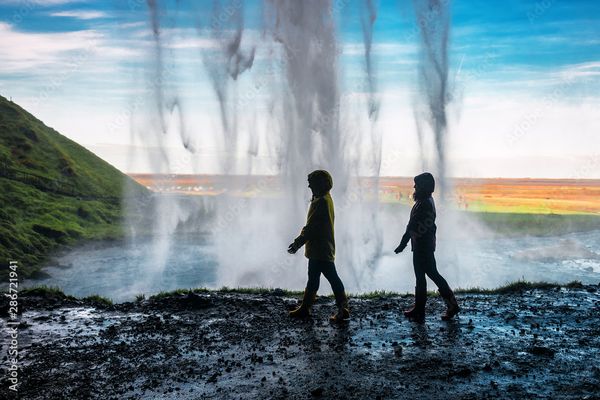
Visit Gljúfrabúi Waterfall
Follow a short trail for about 5-10 minutes to the north and you’ll find the second waterfall in the area, Gljúfrabúi. It’s not immediately visible; this one is tucked inside a mossy canyon. You’ll need to wade through a shallow stream or balance along rocks to enter, but once inside, it feels like a secret world. Again, you will get wet if you visit this one, so your rain gear and waterproof boots are essential.
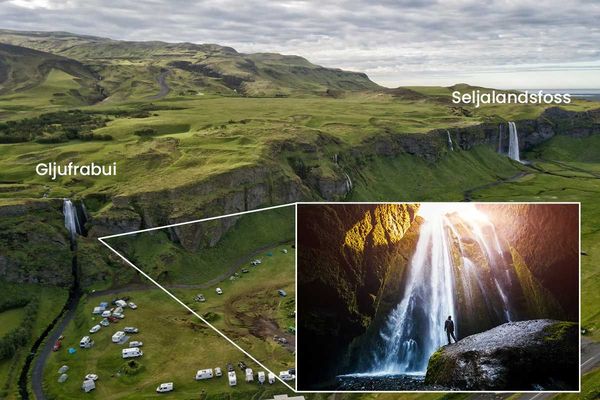
Stay After Dark
In summer, Seljalandsfoss is lit up at night. If you're camping nearby, come back after the crowds leave to see the waterfall glowing against a dusky sky. It’s peaceful and eerie in the best way.
Photography
This spot is a dream for photographers:
- Wide-angle shots from behind the falls
- Silhouettes of people in the mist
- Rainbows when the sun hits right
- Long exposures for silky water trails
- Sunset or northern light shots
Things to Do Nearby
Seljalandsfoss really marks the beginning of the South Coast of Iceland, which is packed with amazing things to see and do. Here are the best natural attractions and activities nearby, all within a short drive.
Skógafoss Waterfall
About 25 minutes east, Skógafoss is one of Iceland’s most iconic and powerful waterfalls. You can climb the 527 steps to a panoramic viewpoint or begin the famous Fimmvörðuháls trail from the top. It’s a must-see stop, especially if you’re continuing along the Ring Road.
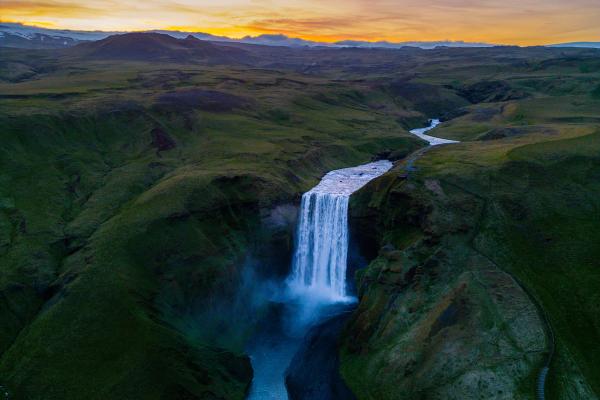
Seljavallalaug Swimming Pool
Tucked into a mountain valley 20 minutes west of Seljalandsfoss, Seljavallalaug is one of Iceland’s oldest pools, built in 1923. It’s naturally heated and framed by rugged green cliffs, although the water here isn’t the warmest. To get there, you’ll take a scenic 20-minute hike along a rocky riverbed – bring a towel and prepare for minimal facilities, although there is a changing room.
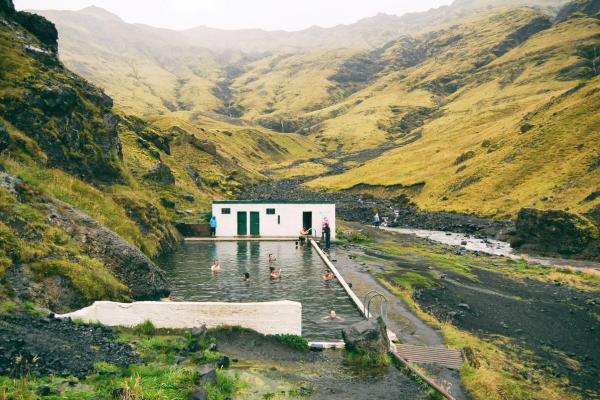
Nauthúsagil Ravine
This hidden gem is just a 5-minute drive from Seljalandsfoss (follow Road 249 further north) and requires a short but adventurous hike into a narrow gorge filled with moss-covered walls and small waterfalls. The trail involves stepping stones, shallow stream crossings, and some mild scrambling – wear waterproof boots to best enjoy this under-the-radar hike.
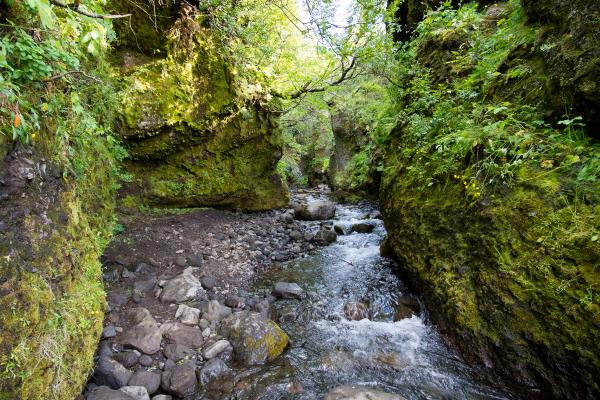
Sólheimajökull Glacier
Located a little bit further east of Skógafoss, Sólheimajökull is a dramatic outlet glacier from the Mýrdalsjökull ice cap. This is a hot spot for guided tours; join a guided glacier hike for a close-up look at crevasses, blue ice, and volcanic ash patterns, or opt for a kayaking tour in the lagoon that has emerged as the glacier tongue retreats further inland.
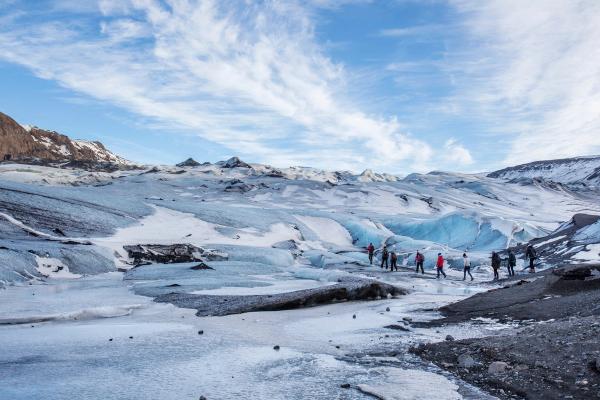
Eyjafjallajökull Visitor Center
This small but insightful center is just 10 minutes away and shares stories of the 2010 eruption that stopped air traffic across Europe. It’s run by a local farming family and gives you a grounded look at living under an active volcano. Plus, there’s a great bakery here full of delicious pastries.
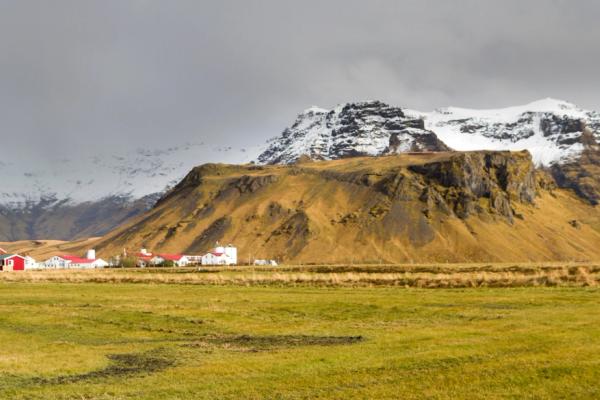
Sólheimasandur Plane Wreck
About 30 minutes east along the ring road lies the parking area for one of Iceland’s strangest sights – a US Navy DC-3 that crash-landed on the black sand beach in 1973. The wreck is reachable via a 7 km round-trip hike across a stark, wind-blasted plain. It’s moody, remote, and eerily beautiful – just be prepared for a long, flat walk. However, we wouldn’t say this place is an essential stop unless you’re especially into photography or abandoned places.
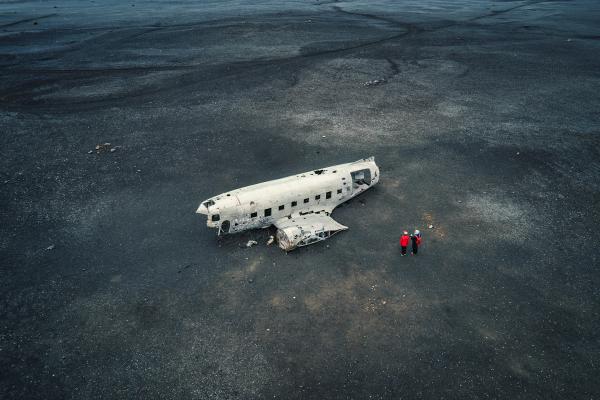
Catch the Ferry to the Westman Islands
From the Landeyjahöfn ferry terminal – just 15 minutes southwest on the coast – you can sail to the Westman Islands (Vestmannaeyjar), home to puffin colonies, a volcanic museum, and some of Iceland’s most dramatic coastal cliffs. Ferries run regularly in summer and take about 35 minutes.
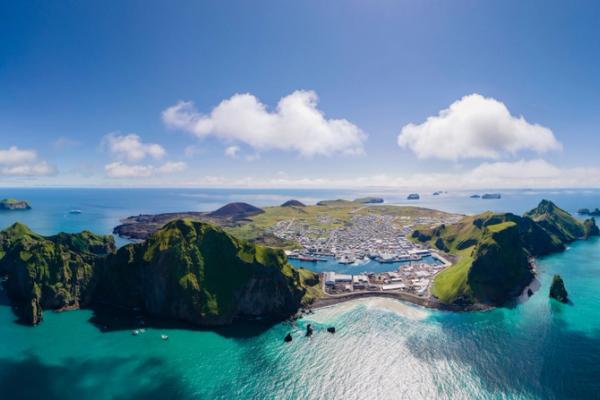
Dyrhólaey Peninsula
Roughly 50 minutes east of Seljalandsfoss (and just before you reach Vík), Dyrhólaey is a rocky promontory that juts out into the Atlantic, offering some of the best coastal views on the South Coast. The towering sea arch, black sand beaches, and puffin nesting cliffs (in summer) make this a standout stop. From the upper viewpoint, you’ll get sweeping panoramas in every direction – waves crashing below, Mýrdalsjökull glacier behind, and endless black coastline stretching west.

Reynisfjara Black Sand Beach
Located just before Vík, Reynisfjara is Iceland’s most famous black sand beach – and one of its most photographed. With towering basalt columns, crashing Atlantic surf, and the jagged Reynisdrangar sea stacks offshore, this place feels otherworldly. It's beautiful but dangerous: sneaker waves here are powerful and unpredictable. Always stay well back from the waterline and never turn your back on the ocean.
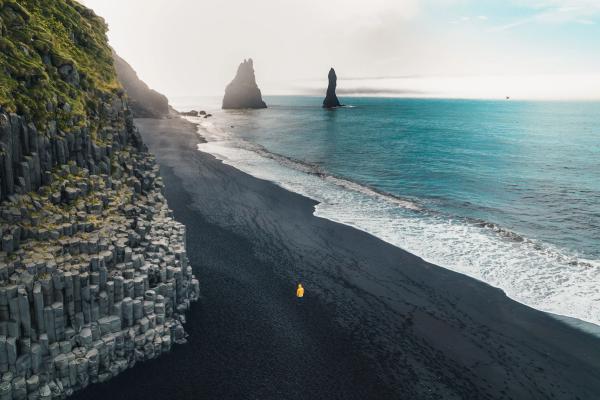
Vík í Mýrdal
About 45 minutes east, Vík is a cozy coastal village known for its black sand beaches, basalt sea stacks, and charming, red-roofed church.
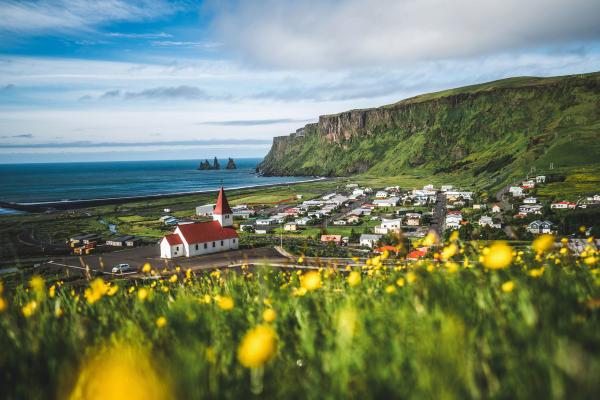
Campsites Near Seljalandsfoss
While you can’t stay overnight in the main Seljalandsfoss parking lot, there are several good campsites nearby – ranging from scenic farm stays to well-equipped options with hot showers. Here are your best choices:
Skógar Campsite
Located about 30 minutes east in the village of Skógar, this campsite puts you right next to Skógafoss waterfall. It’s one of the most iconic camping spots in Iceland – close enough to hear the thunder of the falls as you drift off to sleep. Facilities include:
- Toilets and showers (extra fee)
- Drinking water and simple outdoor kitchen area
- No need to book in advance
- Costs around 2,200 ISK per night (approx. $17 USD)
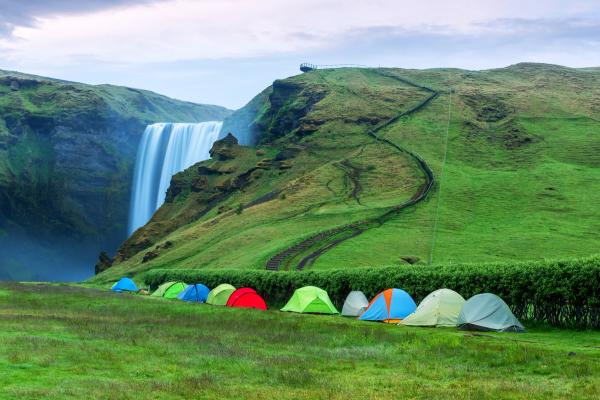
Hotel Fljótshlíð Campsite
This small, peaceful campsite is part of Hotel Fljótshlíð on a working farm in Smáratún, about 20 minutes west of Seljalandsfoss. It’s surrounded by open fields and offers a quiet atmosphere with great mountain views. Facilities include:
- Toilets and hot showers
- Cooking facilities and dishwashing sinks
- Access to hotel restaurant and bar
- Electric hookups are available
Hellishólar Campsite
Located 25 minutes west of Seljalandsfoss in Fljótshlíð, this is one of the more developed campsites in the region. It’s spacious, family-friendly, and surrounded by farmland and small streams. Facilities include:
- Toilets, hot showers, and laundry
- Playground and mini golf (in summer)
- Electric hookups and a small shop
- Open year-round
Langbrók Campsite
This lesser-known site is about 15 minutes northwest of Seljalandsfoss, offering a peaceful, no-frills experience near the base of Eyjafjallajökull. It’s usually quiet and surrounded by farmland. Facilities are minimal but include:
- Basic toilets
- Drinking water
- Limited shelter from wind
Note: Overnight parking is not allowed at Seljalandsfoss itself – please use official campsites. Always follow Leave No Trace principles and stay on marked roads and parking areas to help protect Iceland’s fragile landscapes.
Visiting Seljalandsfoss in Iceland
Seljalandsfoss offers something few places can – a chance to stand behind a powerful, crashing waterfall. As the first sight along Iceland’s South Coast if you’re traveling from Reykjavik, it’s a great stop to make, whether you’re here for a quick 20-minute look or linger for an hour or two to see Gljúfrabúi or catch a sunset. Rain or shine, summer or winter, this waterfall lives up to the hype.

